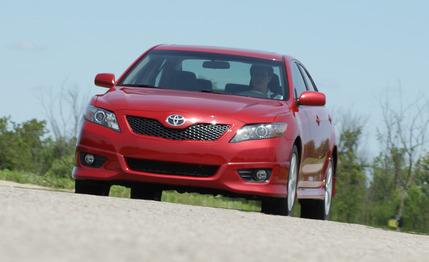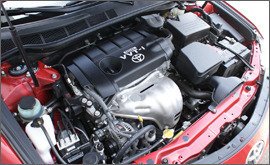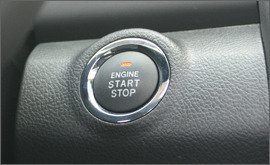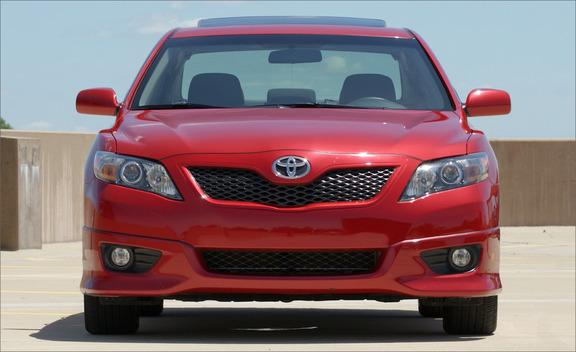
 Short Take Road Test
Short Take Road Test
Until Toyota’s world turned upside down and its cars allegedly started running amok, the Camry was the bestselling mid-size sedan in America. Even after all its travails, the Camry is still vying for number one with the Honda Accord and is on course to sell more than 300,000 units in 2010—albeit with the aid of the kind of incentives Toyota hasn’t needed before.
We’ve always been mystified as to how and why the Camry outsold cars like the Honda Accord, except on the back of its once-sterling reputation for quality and reliability. Now that Ford has reworked its Fusion to good effect and there are new and improved Mazda 6s and Hyundai Sonatas on the market, we are even more flummoxed.
More of the Same
That’s despite a number of changes Toyota made to the 2010 models. Externally, the Camry gains a revised grille and front bumper, larger projector headlamps, reworked taillights, and an enlarged lower front air intake. It’s still as beautiful as an anteater, though, and looks downright dowdy alongside the boldly styled new Sonata.


More significantly, the 2010 four-cylinder models get a larger 2.5-liter engine in place of the previous 2.4-liter. Like the outgoing four-cylinder, the 2.5 features variable valve timing. The base engine now makes 169 hp and 167 lb-ft of torque, up from 158 hp and 161 lb-ft. Sportier SE models like our test car get a power boost over the base engine, which wasn’t the case before. Horsepower and torque are now 179 and 171, respectively. The automatic and manual transmissions each have an additional ratio, for six apiece. In addition, all Camrys now have stability and traction control as standard features.


The sportier SE grade wears aluminum 17-inch wheels fitted with 215/55 tires, up from the base car’s 215/60 15-inchers; a blacked-out grille; fog lamps; chrome dual exhaust tips; and a body kit. Inside, the SE is distinguished by a leather-wrapped steering wheel and shifter, blue gauge lighting, and aluminum pedals and sill plates. There’s a sport suspension to go along with the more powerful engine. The base price of an automatic SE is $23,970, which was swollen to $28,530 on our tester with things like keyless entry and start, a fine navigation system, and a power sunroof. And no, that price doesn’t include leather seats.
The interior is roomy, with an excellent back seat that offers as much room as anything in its class. Typical for a Toyota, the controls are well laid out and easy to operate. Against that, the fit and finish is merely good rather than class-leading, and the materials are surpassed by those in the Sonata, for sure, and even by the revamped Fusion, which is somewhat shocking.
Improved Underhood, but Not Anywhere Else
The 2.5-liter engine is a definite improvement over the old 2.4. Although it’s not as sweet as an Accord’s four-cylinder, it is still very refined and pushes the car from 0 to 60 mph in 8.1 seconds. (The Sonata takes 7.8 seconds and the Accord 8.2 seconds.) The new six-speed automatic transmission is subtle and smooth and is part of the reason the EPA city and highway gas mileage has improved from 21 and 31 mpg to 22 and 32 mpg, respectively.
On the highway, the Camry floats along in a way that your grandparents would love, although there’s quite a lot of tire and wind noise at mildly illegal speeds. That’s where the good news ends. The steering is like a sullen teenager, slow to respond and uncommunicative. The brake pedal is soft and mushy, as if Toyota wanted to make sure that none of its more dimwitted drivers could confuse the pedal that makes the car go with the one that makes it stop.


The SE is supposed to be the sporty Camry. On a curvy road, though, it’s not a willing accomplice. Apart from the slow steering, the body control is merely average, and it will push resolutely before the stability control comes in to shut down any potential fun. It’s not bad, necessarily, but any driving pleasure has been engineered out of the equation.
Reliability over Substance
The reason Camry sales are in trouble isn’t just that it has suffered from some major quality issues. It’s that Toyota has relied so long on its quality and durability that it has taken its eye off the ball with its products. Even this, the supposedly engaging member of the Camry family, utterly fails to entice us. In the meantime, the likes of Chevrolet, Mazda, Honda, Hyundai, and Ford have improved the quality of their vehicles while providing other reasons for buying them, such as more distinctive interior and exterior styling, better perceived interior quality, and more driving pleasure. The Camry doesn’t need just a face lift. It needs a reimagining.